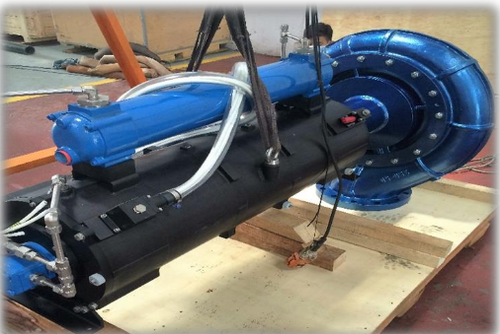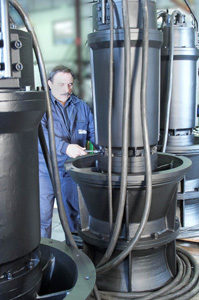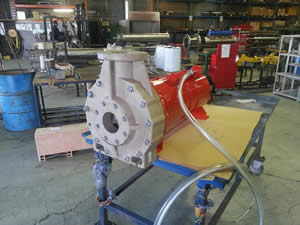Subsea Trencher Electric driven Water pumps
The first design decision required will be to evaluate direct electric drive or indirect hydraulic drives for the water pumps. This is critical to the whole concept of the Trencher. It is therefore necessary to evaluate the advantages and disadvantages of each system s follow:

Electric drive advantages:
- High efficiency
- Simple system
- Minimum components
- Enhanced reliability
Electric drive disadvantages:
- Limited maximum speed (synchronous speed)
- No speed control below synchronous
- High weight of motors
- Large number of prime movers required
- No ability to share power between users.
Hydraulic drive advantages:
- Much higher maximum speed ability
- Step-less speed control up to maximum
- Relatively light weight of motors
- Fed from common systems leading to…
- Step-less power sharing between pump systems and between pump systems and propulsion
Hydraulic drive disadvantages:
- High power losses due to multiple efficiency losses
- More complex system leading to…
- Reduced reliability.

To evaluate the two systems the power balance of the complete vehicle must be calculated under a range of operational scenarios. An assumption will be made that the vehicle will only operate in soft soils when “flying” and will be in a tracked mode (if applicable) when operating in stiff soils.
When flying, the vehicle thruster system is the major power user and thrust is also required to counterbalance the jet thrust from the tool. On tracks the propulsion power demand is almost insignificant and jet forces are reacted by the vehicle weight. The ability to shift power from propulsion to jetting when on tracks is therefore extremely beneficial.
Moreover, when trenching in stiff soils the requirement to use wash jets to clear the trench is significantly reduced, whilst power to the high-pressure jets is at a maximum. In soft soils power must be concentrated in the low-pressure jets to clear large volumes of soil. It is also advantageous to minimise jet reaction while flying so as to minimise vertical thruster use.
It is therefore useful to have the ability to “turn down” the jetting power to the minimum required to cut the trench.
The evaluation of power balance showed that the power loss from using hydraulic drives is far outweighed by the advantages of their flexibility.

As the hydraulic drives can run to high speeds, the size and weight of the high-pressure pumps can also be minimised by running them at up to 4500 rpm.
Finally, the concept of tool mounted pumps requires that the pump drives are of minimum weight and size to make deployment feasible.
For these reasons the power loss and complexity of hydraulic drives are accepted into trencher designs. Care in detail will be employed to minimise the complexity of the variable speed drives and maximise reliability.
The water pumps themselves make use of high-speed high-pressure pumps and aluminium low-pressure pumps to minimise weight.
